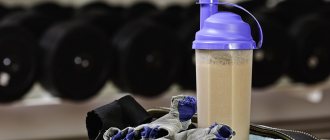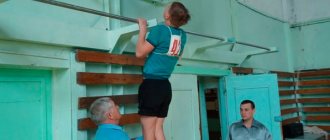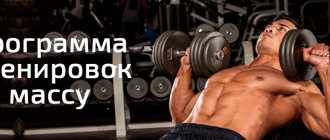Training programsWeight programs
TISL-4 is a highly effective method for gaining muscle mass, consisting of four cycles (each lasting one week): working with heavy weights, high-intensity training, working with medium weights and working with light weights.
Author:
Ian Colman
The technique allows you to use almost any split. However, I believe that the most effective way is to split your workouts into 4 days. You can also work on a 3-day split, but this article will not discuss such a technique.
4-day split using the TISL-4 method
The split can be done in either of two ways: either as described below, or by alternating 2 training days with one rest day.
- Day 1
– chest, biceps and abs - Day 2
– Quads, Hamstrings and Calves - Day 3
– rest - Day 4
– Shoulders, Triceps and Abs - Day 5
– Back, Traps and Forearms - Day 6
– rest - Day 7
– rest or start a new cycle with the exercises of day 1
Endocrine Stimuli of Hypertrophy
The endocrine system produces hormones that control cell function. Mechanical and metabolic stress affecting muscle fibers affects the endocrine system, which increases the production of hormones responsible for the restoration of damaged muscle tissue and the formation of new cellular proteins. The hormones testosterone (T), growth hormone (GH), and insulin-like growth factor (IGF-1) are released as a result of resistance training and promote the synthesis of proteins responsible for muscle repair and growth (Schoenfeld, 2010; Vingren et al., 2010; Crewther et al., 2006). The level of protein utilization and subsequent muscle growth is associated with damage to muscle fibers that contract during training. Moderate to heavy weights lifted for high repetitions can generate high levels of mechanical force that increase damage to muscle proteins and signal the production of T, GH, and IGF-1 to remodel proteins and build new muscle tissue (Crewther et al., 2006 ).
Resistance training produces immediate and long-term adaptations in the endocrine system that are important for muscle growth. In the acute phase, immediately after exercise, the endocrine system will produce T, GH, and IGF-1 to promote repair of damaged tissue. Long-term adaptation consists of an increase in the number of receptors and binding proteins that allow more efficient use of T, GH and IGF-1 for tissue repair and muscle growth (Schoenfeld, 2010; Baechle and Earle, 2008; Crewther et al., 2006). Schoenfeld (2010) noted that muscle damage resulting from mechanical stress and metabolic stress from high-intensity exercise is an effective stimulus for the release of hormones responsible for cell repair, and IGF-1 is probably the most important hormone in increasing muscle growth. It has not been determined which type of stress, mechanical or metabolic, has a greater effect on the endocrine system, however, research suggests that organizing the intensity and volume of training towards lifting heavy weights with short rest periods can lead to increased production of anabolic hormones that promote growth. muscles (Schoenfield, 2013; 2010; Wernbom, Augustsson and Thomee, 2007; Crewther et al., 2006).
Training using the TISL-4 method
The TISL-4 method for gaining muscle mass consists of 4 different types of training, which alternate at intervals of one week (or every 6 days).
- Week 1
–
Heavy
weights, doing basic exercises, 5-7 reps per set. - Week 2
–
And
intensive training, emphasis on the negative phase (with execution at a slow pace), training to failure, pre-exhaustion and drop sets. - Week 3
–
With
medium weights, performing a set of basic exercises and exercises on machines, 10-12 repetitions in each approach. - Week 4
–
Light
weights, performing isolation exercises, 15-20 repetitions per set.
As you can see, the load decreases in the 2nd and 4th weeks. At this time, the body rests and recovers from the stress received in the 1st and 3rd weeks. However, the process of gaining muscle mass is not interrupted.
Methods for gaining muscle mass. Overview of Basic Systems (Part I)
It’s unlikely that anyone who comes to the gym for the first time sets out to achieve competitive shape. Most people start training for themselves, some need to lose weight, others want to add five kilos. But, getting a taste and seeing the results of progress, the goal begins to grow along with the weight on the bar. And now you’re gaining not 5, but 10. This happened to me too, the mass was still not enough for me, but what can I say, I still don’t have enough of it. Over almost 20 years of my sports and coaching activities, I can evaluate the effectiveness of many training systems and summarize the effectiveness of the methods that I have experienced myself. I offer you my review, which does not claim to be the ultimate truth, based on personal experience and confirmed by practice and analysis of the positive and negative aspects of the main training programs with adjustments made.
No matter how good this or that system is, and no matter how effectively it works for all your friends and even the Olympia star, this does not mean that the same progress will happen to you. After all, any method is just another step on your 8-12 week journey, and, of course, it can lose its effectiveness faster than you see its results on your body. If it were that simple, everyone would be at least an Apollo. Therefore, I insist that the system in the context of each individual person is a kind of plan, which is a hybrid of the principles of various techniques, each of which has a certain rational formula that is suitable for you, necessarily adjusted to suit individual needs.
Abbreviated program 5 x 5
This method is very popular among those whose goal is to increase muscle mass and strength. The program is built from two warm-up and three target sets of basic exercises (squats, deadlifts, bench press, etc.) for five repetitions. A special feature of this complex is that it works the main muscle groups of the upper and lower body within one workout.
And, although many believe that this method is only good for advanced athletes, as it can quickly lead to overtraining, I achieved good results using this program at the initial stage of my sports career. Therefore, I consider it suitable specifically for beginners during the period of mastering technology. By very slowly increasing working weights, you can achieve a gradual adaptation to stress and strengthen the ligamentous apparatus well.
But, whatever one may say, abbreviated programs are not capable of providing proportional development of the entire body, which is precisely the goal of bodybuilding. Here, a imbalance in the development of various muscle groups can occur, when the dominant muscles, that is, more responsive to the load by increasing their volume, make the lagging muscle groups look even smaller in comparison. And you are unlikely to be able to catch up with those lagging behind and even out the proportions using single basic exercises.
Thus, having raised your strength using the shortened method, you still need to choose a further plan. In my practice, after one such cycle, the further course usually changes towards adding other necessary exercises and/or changing the nature of their implementation. Very often I change my favorite type of periodization - linear to intensity cycling with the addition of high-repetition training.
The disadvantages of this technique include the lack of cardio loading and stretching, which, based on experience, leads to the loss of not only the endurance and recovery abilities of the body, but also the elasticity of the ligamentous apparatus.
Let's summarize. Abbreviated programs are the basis, a kind of core for any beginning athlete. It's important to stay focused on proper form and slowly progressing with the weights to help avoid injury. This method has proven itself well as a way to strengthen the central nervous system and discipline you under conditions of tough training, since when working according to this plan, you cannot disrupt the training cycle by any step to the left or right, and you can only change the weight of the weight and only in a positive way. And, believe me, after such a 12-15 week cycle, any split system will seem like just a song to you.
As for advanced athletes who use volume training, for them the shortened method will be a kind of psychological relief. It will improve your strength and shake up your hormonal system.
I almost forgot! Shortened programs are perhaps one of the most optimal ways of training to maintain anabolism in your muscles during the PCT.
German or German volume training or set-repetition scheme
I invented this bike before I even knew it existed and used this method to shock my muscles. Later, having studied all the theoretical details of the volumetric training system, I was able to formulate my conclusions regarding its effectiveness, although, I will not lie, in practice I have never managed to complete the entire cycle to the end.
The essence of the method itself is not complicated - we focus on working one or two main muscle groups in one workout, alternating them with other groups 3 times a week. But in order to eliminate the usual way for everyone to work out a single muscle with two or three exercises, the 10x10 scheme comes into play for one, and in some cases for two basic exercises. I would like to note that 10x10 is not a fixed number; no one is stopping you from working according to the 8x8 or 12x12 scheme.
But still, I don’t consider this method of training a technique. This is something like increasing the intensity like using a pre-exhaustion or a drop set.
My experience has proven that volume training, like the previous one, can cause a bias in muscle development due to the emphasis on working selected areas of our body using the same chest presses or squats. And, although I am a supporter of basic training, I try not to deviate from the goal of the harmonious development of all muscle groups. Monotonous performance of the same exercises day after day, year after year is a direct road to injury, as well as to chronic fatigue, which is a catalyst for all kinds of failures in the body.
Conclusion. This method is certainly very effective, both in terms of working out the technical part of the exercises, and in terms of provoking muscle growth by connecting more muscle fibers. But I do not recommend its frequent, let alone long-term (12 or more weeks) use. And, of course, I would not recommend it to those whose sports activity began at the age of “over 40,” since the ligamentous apparatus becomes vulnerable to this type of load over the years.
High Intensity Training (HIT)
I dare to assume that people who read such long texts and are not indifferent to the “iron game” are probably familiar with “Super Training” from Mike Mentzer - one of the most, in my opinion, tough programs, requiring incredible willpower to go to the end. The principle of the system is separate training with a reduced volume of training until complete failure in one approach.
From this method I learned many useful techniques for shocking my muscles. For example, pre-exhaustion, which I often use in my training and when creating programs. Including this technique in the complex allows you to qualitatively feel the working muscle. Or an ultra-slow pace in performing exercises, which allows you to completely eliminate inertia when performing exercises and avoid injuries even when working with heavy weights.
But while practicing this method, the first thing I noticed was the imbalance in the selection of exercises for certain muscle groups. In addition, as I progressed from one cycle to the next, I was puzzled by the minimalism in the variety of exercises. And when squats and deadlifts began to disappear from the program, I began to think about what was more important for me: gaining more mass or acquiring harmonious proportions.
In addition, bodybuilding is, first of all, a healthy lifestyle, in which not only harmony in appearance is important, but also the balanced development of all systems of its functioning: from banal flexibility and mobility of the joint-ligamentous apparatus to aerobic endurance with a fully functioning cardiovascular system. system. Strictly adhering to the HIT scheme, excluding stretching and periodization of training, working to failure, we are moving towards overloading most of the systems of our body. And, despite the large rest interval between workouts, and HIT implies only four to six extreme anaerobic workouts per month, which theoretically should be enough to restore the body, I consider working in this mode to be contrary to the principles of harmonious and coordinated work of the entire body. The problem may even be the fight against excess fat deposits.
Conclusion. High intensity is for the pros. It makes sense to resort to it in order to explode stagnation in the growth of muscle mass, especially after a long cycle of volumetric training strictly subject to alternating intensity: from moderate-intensive load to failure.
Split training method
Every athlete sooner or later comes to this system in search of an effective formula. Some instructors even sell it to beginners as the shortest path to “Zen.” Therefore, the popularity of the method is growing day by day, and split variations are already a dime a dozen. If I had made an attempt to choose the right program from the existing variety, taking into account the individual characteristics, level and goals of the athlete, believe me, it would have been easier to create a new one.
It is generally accepted that split training involves separate training for different muscle groups with a regulated recovery period. But in practice such a separation is impossible to achieve. Often, the intention to punch a muscle with a large number of exercises from different angles from all angles causes the ligaments to wear out and results in overload of the joints, most often the shoulder and elbow, as well as the lumbar spine. I already wrote about the fact that it is impossible to organize the exclusion of, for example, the shoulder joint from any day of the split in the article “Training without injuries. What we should know about the rotator cuff muscles.
Another point that can influence the choice of a beginner is the development of strength. Under split system training conditions, the increase in strength indicators occurs, to put it mildly, slowly, if not completely absent. conclusion suggests itself - the essence of the method is not to increase the level of fitness, but rather to high-quality polishing of pre-prepared meat. In my practice, this method turned out to be effective specifically for detailed development of the muscle mass at the stage of preparation for competitions. It makes it possible to “stretch out” the missing muscles, add depth and separation, allows you to focus on the lagging muscles and hit them pointwise.
In addition, this method is indispensable when assembling training complexes for people with diseases of the musculoskeletal system that limit or exclude work with basic exercises, as well as at the stage of rehabilitation after injuries.
Continue the review via this link.











